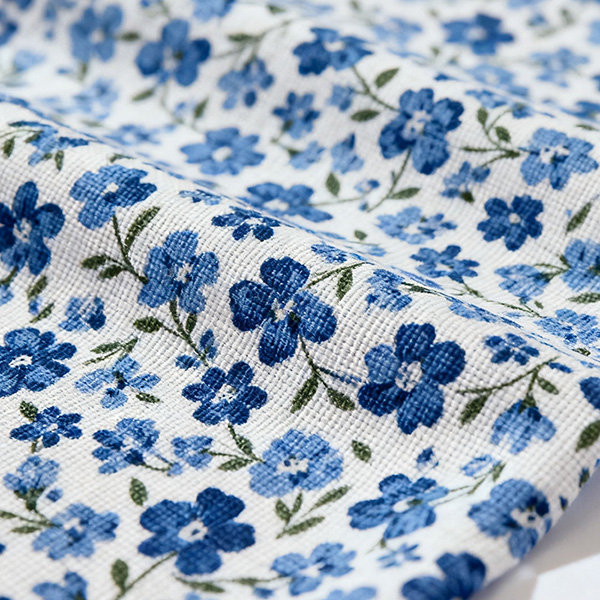Caring for blue floral Cotton Fabric properly is key to preserving its color vibrancy, preventing pattern fading, and maintaining the fabric’s softness and structural integrity over time. Below is a step-by-step guide covering all critical care aspects, from pre-washing to long-term storage.

Cotton fabric (especially unwashed or newly purchased) often shrinks by 3-5% when first exposed to water. Pre-washing also removes excess dye (common in printed fabrics) that could bleed onto other items later.
Wash separately: Use cold water (30°C/86°F or below) to minimize dye release. Hot water accelerates color fading and shrinkage.
Mild detergent only: Avoid harsh detergents with bleach, optical brighteners, or strong enzymes—these can break down cotton fibers and fade the blue floral pattern. Opt for a gentle, pH-neutral detergent (e.g., Woolite, or detergents labeled “for delicate fabrics”).
Skip fabric softener (optional): While softener adds softness, it can leave a residue that dulls printed patterns over time. If you prefer softness, use a small amount (half the recommended dose) for subsequent washes.
After pre-washing, follow these rules for regular cleaning:
Sort by color & fabric type: Wash blue floral cotton with other dark/navy items (never whites or light colors) to avoid dye transfer. Separate heavy fabrics (e.g., cotton upholstery) from lightweight ones (e.g., cotton lawn) to prevent friction damage.
Water temperature: Stick to cold or lukewarm water (max 40°C/104°F). Hot water causes cotton to shrink permanently and fades the blue hue and floral details.
Wash cycle: Use a “delicate” or “gentle” cycle for lightweight cotton (lawn, poplin) to reduce agitation. For heavier cotton (upholstery, thick calico), a “normal” cycle is safe—but avoid high-speed spins (opt for low or medium spin to prevent wrinkling).
Avoid bleach: Chlorine bleach and oxygen bleach (even “color-safe” versions) can strip the blue dye and weaken cotton fibers. Never use them on printed cotton.
How you dry the fabric directly impacts its longevity—heat is the biggest enemy of cotton and printed patterns.
Air-dry (preferred): Hang the fabric flat or on a clothesline in **shade** (not direct sunlight). Sunlight’s UV rays fade the blue color and bleach floral patterns over time. For delicate items (e.g., cotton lawn dresses), lay them on a clean towel to air-dry to prevent stretching.
Machine drying (if necessary): Use the lowest heat setting (or “air fluff” mode) and remove the fabric promptly when dry (over-drying causes shrinkage and stiffness). Add a dryer sheet only if needed—too many can leave a dull residue.
Never wring: Wringing cotton (especially printed varieties) can distort the fabric, stretch fibers, and smudge the floral pattern. Gently squeeze out excess water instead.
Cotton wrinkles easily, but ironing correctly keeps it looking crisp without harming the pattern.
Temperature setting: Set your iron to the “cotton” setting (usually medium-high, 150-180°C/300-350°F). Avoid using the “linen” setting (too hot) or “silk” setting (too cool, won’t remove wrinkles).
Iron inside-out: Always iron the backside of the fabric (never directly on the printed floral side). Direct heat on the print can melt or fade the ink, especially if the fabric uses pigment-based dyes.
Use steam (carefully): Steam helps relax wrinkles, but avoid excessive steam on the printed side—moisture can cause the dye to bleed or blur. If steaming, hold the iron 1-2 inches above the fabric (don’t press down).
Skip starch (optional): Starch adds crispness but can make cotton stiff and attract dirt. For formal items (e.g., cotton poplin blouses), use a light starch—heavy starch weakens fibers over time.
Act fast on stains to avoid permanent damage, but never use harsh chemicals on printed cotton.
Blot, don’t rub: For fresh stains (coffee, wine, food), blot the area with a clean, damp cloth to absorb the stain. Rubbing pushes the stain deeper into cotton fibers and can smudge the print.
Mild stain treatments: Use a small amount of gentle detergent or a stain remover labeled “for colored fabrics” (test it on an unseen corner first to check for dye bleeding). Let it sit for 5-10 minutes, then wash as usual in cold water.
Avoid harsh solvents: Acetone, ammonia, or alcohol-based cleaners can dissolve the print ink—never use them on blue floral cotton.
Proper storage keeps the fabric free from mold, mildew, and pest damage.
Clean first: Never store dirty or damp cotton—food residues, sweat, or moisture attract moths and cause mildew (which stains and weakens fabric). Ensure the fabric is 100% dry before storing.
Fold, don’t hang (for lightweight items): Hanging lightweight cotton (e.g., dresses, scarves) for long periods can stretch the fabric at the shoulders or seams. Fold them neatly and place in a breathable cotton storage bag (avoid plastic bags—they trap moisture).
For upholstery/curtains: If storing large cotton items, roll them loosely (instead of folding) to prevent creases that set in over time. Add a moth repellent (e.g., cedar chips) to the storage area—avoid mothballs (they leave a strong odor that’s hard to remove from cotton).
Avoid direct sunlight: Store the fabric in a cool, dark closet—sunlight through windows will fade the blue color even when stored.
Test first: Always test a small, hidden area of the fabric (e.g., inside a seam) before trying a new detergent, stain remover, or iron setting.
Wash less frequently: Over-washing weakens cotton fibers and fades prints. Spot-clean small stains instead of washing the entire item.
Avoid high heat: Heat (from hot water, high dryer settings, or excessive ironing) is the main cause of shrinkage and color loss in blue floral cotton.
By following these steps, your Blue Floral Cotton Fabric will retain its vibrant color, soft texture, and crisp pattern for years.